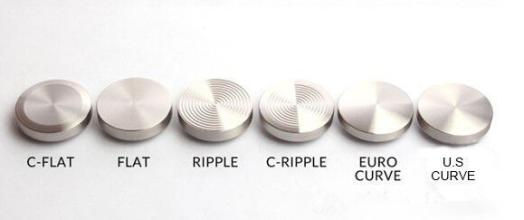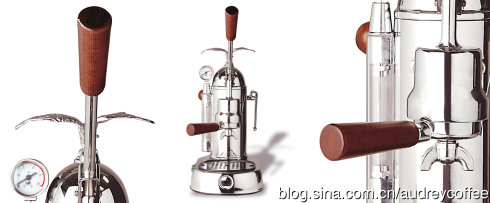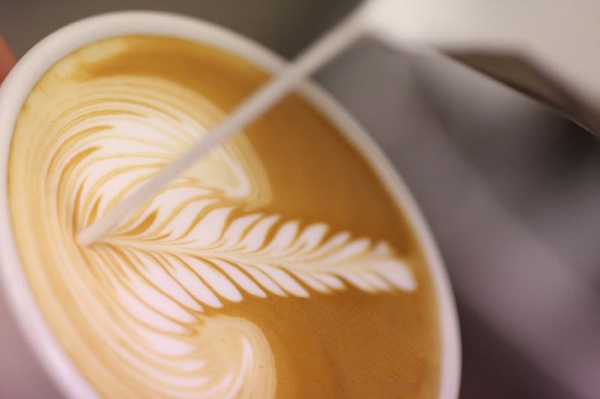Why do you use a powder press to make coffee? How to use the powder press? How to press powder is correct
The powder press (or powder hammer) is one of the most commonly used tools in espresso. So the question is, why use a powder press?
Baristas all know that when using an espresso machine, the hot water brewed has about 9 atmospheric pressure (of course, this is not a fixed value, there are 12 atmospheric pressure or higher), and the pressure is very high, when the water penetrates the coffee cake. the water is inert. What is inertia, that is, water will penetrate through the weakest part of the coffee cake, not from the thickest place. Therefore, if you do not use a coffee powder press to compact and flatten the coffee (to make the density of the coffee powder in the powder bowl as uniform as possible), the essence of the coffee will not be extracted, or some parts will be overextracted. In other words, the main purpose is to flatten and tamp the coffee powder in the handle to form a flat horizontal plane, to better let the hot water be extracted through the coffee powder, and to enable the coffee powder to withstand the tremendous pressure caused by the coffee machine extraction. without being washed away and affecting the quality of the extraction. The force of the pressing powder should be determined according to the grinding thickness of the coffee powder, and the reference basis is the flow rate of coffee during extraction (extraction time 25 ±5 seconds). If the flow rate is too fast, the powder pressing strength is too light; if the flow rate is too slow, the powder pressure is too heavy, which will directly affect the Italian concentrated product and the taste of the coffee. In addition, everyone's application strength will be different, and there is a great difference between boys and girls, so it is necessary to adjust the corresponding strength according to the actual extraction effect. It should be noted that pressing powder is only one of the links, and there are a variety of factors that affect the extraction, such as powder quantity, powder thickness, cloth powder, pressing powder, which need to be taken into account.
The following is an introduction to the various types of common powder presses (based on the diameter 58mm):

The classification of powder press is mainly divided into six categories: 1. Cmurf Flatt; 2. Flatt; 3. Ripplescape 4. Crippletrait 5. Euro Curve;6.American Curve.
The main difference is the bottom shape of the powder hammer.
1.Flat: the most common powder press with a flat bottom at the bottom.
2.Euro Curve: the bottom of the powder hammer is arc-shaped, and the highest height difference at the edge of the powder hammer is in 3.355MM.
3.C-Flat: it belongs to the combination of Euro Curve and Flat. It doesn't have a curved bottom like Euro, but like Euro, the pink hammer has a height difference, the bottom has a horizontal flat bottom, but the edges are curved, and there is a height difference.
4.Ripple: it's hard to control. The bottom of the powder hammer is wavy.
5.C-Ripple: improved on the basis of Ripple, the pink hammer is made into a flat bottom at the edge, with multiple raised concentric circles in the center, and the pressed powder center is wavy and the edge is horizontal.
6.American Curve: relative to the bottom Radian of the Euro Curve, the height difference between the highest point of the arc and the edge of the powder hammer is reduced to 1.661MM.
Generally speaking, the process of pressing powder can be divided into two steps, first pressing once, gently tapping the edge of the powder bowl, and pressing powder for the second time. This is now a more common way of pressing powder (of course, there are other ways). The effect of pressing powder is that pressed powder is tight, and the surface of pressed powder is flat and horizontal. How can such a result be achieved? In addition to the need for many exercises, the two steps of powder pressing are also required.
The first time you press the powder, you need to press it gently. Some say it is heavy pressure, in order to make the coffee powder compact to form a good pressed powder foundation. First of all, heavy pressure can indeed form a good pressed powder foundation (just like laying a foundation, you must have a good foundation before you can build a solid house). But the heavy pressure also has a downside: if the heavy pressure is not well controlled, the surface of the basic coffee pressed powder is likely to be not flat but inclined, so that no matter whether your second powder pressing is light pressure or heavy pressure, you can not correct such noodles. Second, after the first heavy pressure, only a foundation is formed, but the interior is not the most ideal compact state (otherwise only this time pressing powder is enough, and the rest of the action is superfluous), so if light pressure is used when pressing powder for the second time, it is difficult to exert enough influence on the internal coffee powder, if heavy pressure is used, it will destroy the foundation that has been formed, and is not conducive to meeting the requirements of pressed powder. And the first time to press the powder to take light pressure, will reduce these bad effects. With a little pressure, the coffee powder becomes a little tighter, so that the surface of the coffee powder becomes smooth. The act of tapping a powder bowl between pressing powder. The main purpose of this action is to make the coffee powder adhere to the inner wall of the powder bowl fall down (otherwise, when making the extraction, these powders can easily be soaked and stuck to the inner wall of the outlet head, forming black dirt over time). Some people are used to knocking many times, some people are accustomed to knocking on the lower part of the powder bowl, and some people are used to knocking hard at once, which are all bad. First of all, the coffee powder just adheres to the inner wall and can be dropped by tapping it gently, so there is no need to hit it many times or use a lot of strength. Second, although tapping on the bottom of the powder bowl can also make the coffee powder fall, this action can also have a more serious bad effect-- making the internal coffee powder move. Pressed powder, which has been slightly tightened by light pressure (although it may not be visible on the surface), it is difficult for the powder to correct such a mistake. Therefore, the action of tapping should be gentle, and it is best to control the number of knocks within three times along the edge of the powder bowl.
The second pressing powder requires heavy pressure. The coffee powder which has been lightly pressed in front has formed a relatively compact pressed powder, so it needs to be pressed further to meet the compaction requirements of pressed powder required by the production of Espresso coffee. The reason why it is not suitable for light pressure is that the compactness of light pressure pressed powder is not enough to produce rich and mellow espresso. But there are requirements for stress. The heavy pressure is to make the coffee powder more compact and the noodles should be kept horizontal, so the pressure should be big. But the force should also be uniform, otherwise the flour will tilt, or it may look horizontal on the surface, but in fact, the density of the whole pressed powder is inconsistent (some coffee powder is large and compact, in some places coffee powder is less but relatively loose) this will also affect the next step of production and extraction. So the second time to press the powder with heavy pressure, at the same time pay attention to the uniform force (the thumb and index finger can be placed on the upper edge of the powder hammer to touch the upper edge of the powder bowl, according to which it feels like a uniform force). In order to achieve the ideal state, the pressure is generally controlled at three to four times is the best. Some people are used to pressing hard and then rotating the powder hammer to achieve the effect of multiple heavy pressure, but this is a very bad habit. The powder hammer can be rotated between three to four times to sense the overall pressed powder level with the thumb and index finger, but do not press hard during rotation. The rotation with pressure can easily drive the pressed powder to move slightly together, which can easily cause the pressed powder to not combine closely with the edge of the powder bowl, and cracks will appear inside the pressed powder, which will give a relatively loose channel for hot water, resulting in the failure of the final coffee. Pressing powder is the biggest factor in the production of Espresso that can be controlled by manpower in addition to adjusting the degree of grinding. Making Espresso after this step will make it easier to analyze the causes of the bad situation (because it excludes the most uncertain factor of human error). It takes a lot of practice to form good habits. Of course, this is only one of the many ways to press powder, and it is not the only correct way. Keep practicing and summarizing, finding the most suitable way to press the powder is the most important one: one is to flatten the coffee powder and the other is to press the hot water into the coffee powder to ensure that the hot water is immersed in the coffee powder. At the same time, the process of pressing the hot water to filter the coffee can have enough pressure to extract the coffee and press the coffee powder on the powder bowl to ensure the coffee head and coffee powder contact evenly.
Important Notice :
前街咖啡 FrontStreet Coffee has moved to new addredd:
FrontStreet Coffee Address: 315,Donghua East Road,GuangZhou
Tel:020 38364473
- Prev

What are the many factors that affect a perfect cup of coffee?
On the basis of affecting the quality of coffee, we divide the production process into several elements to facilitate the organization of a large number of materials, not to say that these elements are independent of each other or can be defined separately. For example, there are many small factors that affect the pump pressure, we just assume that they are all normal, the valves in the machine are well sealed, and the outlet head sealing ring is soft and tough, ensuring tightness.
- Next

Technical skills of Coffee pattern how to make Coffee pattern well
1. The basic knowledge and technology of coffee flower: the origin, classification and correct concept of coffee flower / related machinery, equipment and materials. two。 The key to the success of the coffee flower: the brewing technology of espresso Espresso / the production of dense and meticulous milk / the perfect fusion of coffee and milk. 3. The basis of all coffee flower drawing techniques is advanced and highly difficult: pull flowers? Species / detailed formula
Related
- What is the meaning of lactic acid fermentation with coffee bean treatment?
- How to judge the state of foam by sound?
- How does the latte pull out the unicorn pattern? Come to get for a little trick to improve the flower pull!
- Will flower pulling affect the taste of the latte?
- Do you know the history of coffee?
- The difference between honey treatment and sun washing what is raisin honey treatment?
- What kind of milk can a novice use to make coffee foam to keep the foam longer? The correct method and skills of milking tutorial sharing
- Why do washed coffee beans taste sour? Flavor characteristics of washed Coffee
- Introduction to the skill of how to practice the size and height of water injection around the circle of hand-brewed coffee
- How do beginners practice coffee flower drawing from scratch?

